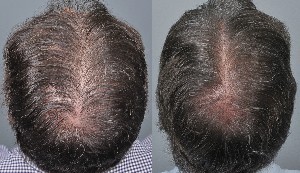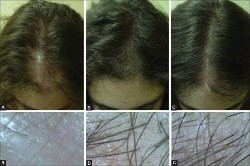This post on PRP treatment for hair loss was first published in March 2014. I have now updated it and added links to more recent studies at the bottom of this post. Note that even the respected Mayo clinic recently found PRP to work to temporarily regrow hair in women.
Update: February 2022 — Yet another new study finds superior hair growth via PRP administered using dermapen microneedling.
Update: October 2020 — New study finds PRP and microneedling combination treatment to be more effective than PRP alone.
Platelet-rich-plasma (PRP) injections will not grow robust plentiful hair in the vast majority of hair loss sufferers. PRP will almost never grow lengthy new hair in areas of the scalp that have been totally bald for many years. If you ever decide to get this procedure, you should go in with modest expectations.
However, there now exist over 50 studies from around the world that have shown PRP to grow at least some hair. More often, PRP therapy will make existing hair thicker. Platelet-rich plasma contains numerous growth factors, many of which are well known to benefit hair growth.

Scroll down to the bottom of this post in order to see the updated list of PRP and hair loss studies. Most of them have detailed patient statistics on success and failure rates. Also make sure to read my post on PRP sometimes making hair darker.
Introduction
As I mentioned earlier, PRP will almost never regrow hair in completely bald areas of the scalp. In most best-case scenarios, PRP treatment will thicken and seemingly improve the density of existing scalp hair. If you are really lucky, it will make recently miniaturized hair grow back stronger and lengthier. Even if effective, PRP is not a permanent solution to your thinning hair loss problems.
Numerous people on online hair loss forums have been disappointed with their PRP treatment results. In stark contrast, on local TV programs in the US, doctors have frequently presented real life patients who claim to be very pleased with their PRP hair growth results. They always show impressive before and after photos and videos as evidence. In most cases, they are likely presenting their absolute best case outcomes.
On realself, as of May 2020, an astounding 87 percent of patients have voted their PRP hair growth results to be worth the expense and effort. I am extremely skeptical about this success rate number. Some great before and after PRP hair loss treatment photos can be found in those realself reviews.
I have not done any research on the reliability and accuracy of these testimonials. On sites such as Yelp, you can find numerous fake ratings and reviews. Youtube also has many videos on PRP and hair loss treatment before and after experiences.
PRP Treatment for Hair Loss
Platelet-rich plasma (PRP) is the concentration of platelets that are derived from the plasma portion of one’s own blood. PRP contains various growth factors, cytokines and other bioactive factors. Because the plasma is autologous (i.e., extracted from a patient’s own blood), there is minimal possibility of any significant adverse side effects.
To obtain PRP, a small amount of blood is first extracted from a patient. This blood is then spun in a centrifuge that leads to separation into three layers:
- Platelet-poor plasma (PPP).
- Platelet-rich plasma (PRP).
- Red blood cells.
The whole procedure typically requires one or two spins of the centrifuge and takes less than 15 minutes. The concentration of platelets in PRP is usually around five times as much as in normal blood. This PRP is then injected into a patient’s scalp in order to try and improve his or her hair.
Platelet-Rich Plasma Growth Factors
The key benefit from platelet-rich plasma seems to arise from various growth factors. The main growth factors in PRP that are relevant to hair growth include:
- Platelet-Derived Growth Factor (PDGF)
- Fibroblast Growth Factor (FGF)
- Insulin-like Growth Factor 1 (IGF-1)
- Vascular Endothelial Growth Factor (VEGF)
- Epidermal Growth Factor (EGF)
- Nerve Growth Factor (NGF)
- Transforming Growth Factor Beta (TGF-β)
Interestingly, a number of other hair loss treatments that I have read about over the years also target one or more of the above growth factors. Among these, the most impressive one is include Shiseido’s Adenosine based products. Adenosine is thought to increase FGF-7, FGF-2, IGF-1, and VEGF.
A company named Follicept was working on a widely touted product to deliver IGF-1 to the scalp. However, it seems to have ceased operations in 2016 after the demise of one its main researchers.
On an important note, it is interesting that one of the ways in which Minoxidil works to grow scalp hair is via the upregulation of VEGF.
Related to this subject matter, a 2017 small-scale study from Spain looked at something called plasma rich in growth factors (PRGFs), and found it to have significant benefits towards hair growth.
Treatment Guidelines
PRP therapy typically consists of three injection sessions spread across a 4-8 week period. Thereafter, maintenance treatments are recommended every 4-6 months. PRP injections are not particularly painful or uncomfortable for most patients. Their nonsurgical nature with negligible chances of side effects is also appealing to many people. Make sure to see this great pre- and post-care instructions resource page.
Among the reasons that PRP results can vary so much include: the significant variance in techniques; equipment used; and concentrations of platelets in the final product. Centrifuge quality, in particular, differs substantially depending on manufacturer.
If you are contemplating getting a platelet-rich plasma treatment on your scalp, it is imperative to choose a reputable doctor. Many hair restoration surgeons have significant experience in the use of PRP for hair growth purposes. Clinics and plastic surgeons that specialize in many different cosmetic procedure are often less preferable to hair experts.
Note that initial shedding after platelet-rich plasma treatment is a common side effect. The bald truth talk forum section on PRP is worth a visit to read about patient experiences and reviews.
PRP and Hair Transplants
If I was undergoing a hair transplant procedure today, I would seriously consider the addition of PRP to the procedure. Even if the benefits are not always guaranteed. An increasing number of hair transplant surgeons are adding PRP to the procedure in the belief that the growth factors improve yields and donor area healing. Some are certain about the benefits. It remains to be seen if this is just a revenue making scheme or a scientifically sound add-on.
Platelet-Rich Plasma Hair Loss Treatment Cost
The cost of PRP for hair loss varies drastically. In the US, the lowest price that I have read about is $500 per treatment. The highest has been $2,500 per visit. The latter is ridiculous, since most people will require a few sessions for optimal results. And the results will often not last for more than a year.
On the realself website that I mentioned earlier, the average cost of PRP treatment for hair loss is $2,125 as of 2020. Most health insurance plans will not cover cosmetic treatments such as PRP for hair growth.
PRP for Hair Loss Clinical Studies
A number of recent studies on platelet-rich plasma have shown favorable outcomes (often when used in conjunction with ACell) on hair growth. I really like the fact that these studies are coming from all over the world rather than from just one country such as the US. This limits the potential for any kind of sponsor-influenced or self-interest-driven fraudulent “findings”.
Sources and References:
Egypt, 2020 — Autologous PRP is a good tool for androgenic alopecia treatment.
United States, 2020 — PRP effective treatment for hair regrowth in female AGA, but not as good as minoxidil. Interestingly, patients preferred their PRP results and quality of life after treatment.
Syria, 2020 — PRP Injections for Men with AGA Show Positive Effect on Hair Density.
Turkey, 2020 — Positive Data on PRP and AGA.
Pakistan, 2020 — Combined SVF-PRP Therapy Benefits Hair Growth more than PRP Alone.
Italy, 2020 — Systematic Review of Platelet-Rich Plasma Use in Androgenetic Alopecia. Only 17% of analyzed studies reported that PRP was not effective in treating AGA.
India, 2020 — PRP and Minoxidil Combination Superior to Either Treatment Alone.
India 2019 — PRP Gives Superior Results to Minoxidil in Treating Androgenetic Alopecia.
Pakistan, 2018 — Effect of Platelets-Rich Plasma on Scalp Hair Diameter.
USA, 2018 — Platelet-Rich Plasma for the Treatment of Female Pattern Hair Loss: A Patient Survey.

Spain, 2017 — A Proposal of an Effective Platelet-Rich Plasma Protocol for the Treatment of Androgenetic Alopecia. Image on the right is one of several included in this paper, and shows the patient’s scalp and closeup view of the hair via magnification.
Thailand, 2015 — At the 9th Congress for Hair Research, Dr. Ratchathorn Panchaprateep from Thailand presented favorable findings regarding combination therapy treatment of hair loss using PRP and Non-Ablative 1,550 nm Erbium Glass Fractional Laser in 9 patients.
India, 2015 — PRP is Effective in the Treatment of Androgenic Alopecia, with no Side Effects.
Greece, 2014 — Study of Platelet-Rich Plasma Injections in the Treatment of AGA over a 1-year Period.
Italy, 2014 — Platelet-Rich Plasma for Androgenetic Alopecia: A Pilot Study.
India, 2014 — Platelet-Rich Plasma in Androgenic Alopecia: Myth or an Effective Tool.
France, 2013 — Platelet-Rich Plasma: a Therapy for Hair Growth.
Brazil, 2012 — Follicular Unit Megasessions and Platelet Growth Factors.